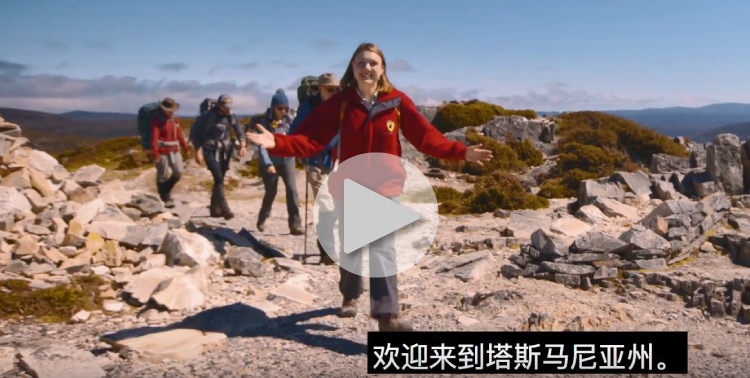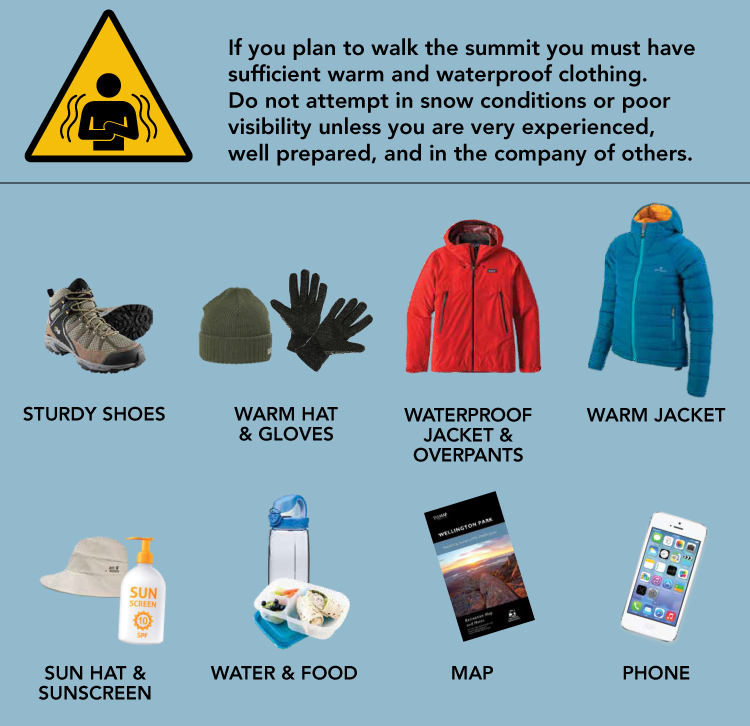Tasmania is renowned for its magnificent bushwalking, but if you're not well prepared our weather can be dangerous.
The Parks and Wildlife Service developed a video on bushwalking preparation and essential tips for a safe walking experience. Their advice is important for walking on kunanyi/Mt Wellington and includes Mandarin subtitles: PWS safety video.

For every 100 metres you ascend the temperature typically falls a degree. From The Springs to the summit the altitude increases by 600 metres. The temperature at the top is likely to be 6°C colder than The Springs – and if it’s windy, it will feel even colder. Be prepared to turn back. Low cloud can reduce your visibility to a few metres. All tracks can be slippery when covered in snow and ice.

General safety advice
While we strive to keep Pinnacle Road to the summit of kunanyi / Mount Wellington open, sometimes this is not possible due to heavy snowfalls or icy conditions.
- Always check the road and weather conditions before you go.
- Check the weather conditions before you leave home. Click here to see the weather forecast on the Bureau of Meteorology website, or check out our pinnacle webcams.
- Check the road closure status.
- Pack warm clothing.
- Drive carefully, leaving double the normal distance between your vehicle and the one in front of you. Remember braking takes much longer in icy conditions.
- Be patient on the road as traffic may be slow.
Weather conditions can change quickly in Tasmania – especially on the mountain. Icy winds, snow, low cloud and heavy rain can occur at any time of year – and in summer, bushfires. Alpine conditions can be life threatening.
Water
Carry adequate drinking water. Tap water at The Springs is collected from the mountain. Natural surface water in the park may not be safe to drink and may be hard to find at higher altitudes.
Leave a plan
Tell someone reliable where you are going and your anticipated return time. This will help find you in an emergency. It's safer to walk with others.
Mobile phone reception is variable. Install the Emergency+ app on your smartphone and learn how to use it - emergencyapp.triplezero.gov.au
Cold, wet and windy conditions can quickly cause a drop in core body temperature (hypothermia). It can take as little as 30 minutes from the initial symptoms to unconsciousness.
- Wear warm and waterproof clothes; eat and drink regularly.
- Symptoms: shivering, clumsy, confused, slurred speech; those affected may deny they have a problem.
- Treatment: make or find shelter immediately, get into warm and dry clothes, give warm sweet drinks, seek urgent medical help.
Watch this short hypothermia safety video below to understand the dangers of being cold and how to be prepared (Chinese subtitle version).
For help in a life threatening or emergency situation, call emergency services (000) for police, fire or ambulance.
This country burns easily and devastatingly quickly. Only use designated hut fireplaces. Use firewood provided or BYO. It is an offence to collect firewood from Wellington Park.
The park will be closed on days with dangerous fire weather. If you plan to walk on days with elevated fire danger, carry a phone or Personal Locator Beacon, and have a carefully planned exit strategy.
In the event of a bushfire in the park, leave immediately via the safest route. If you are caught, phone 000.